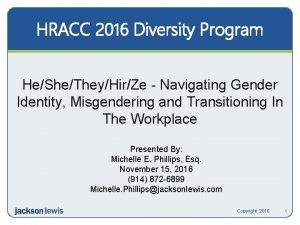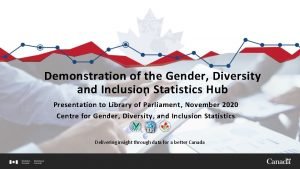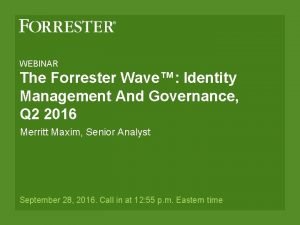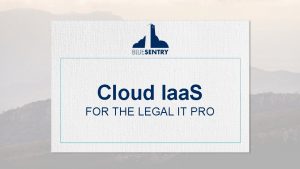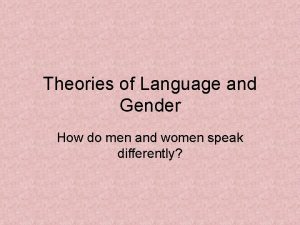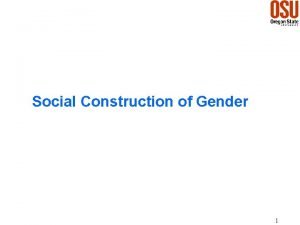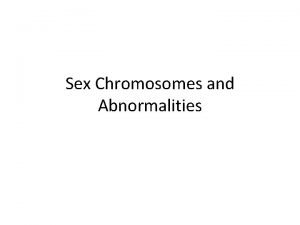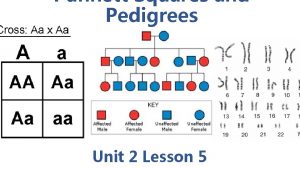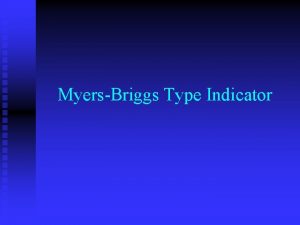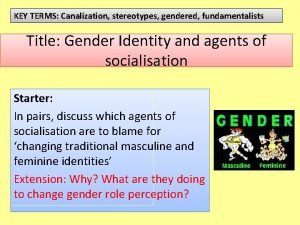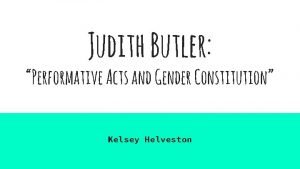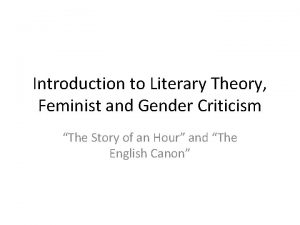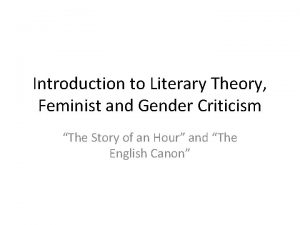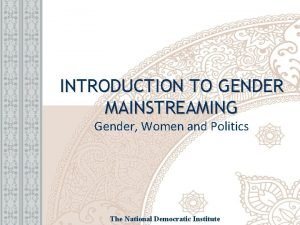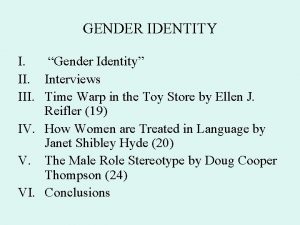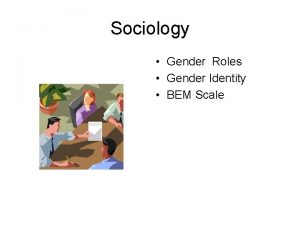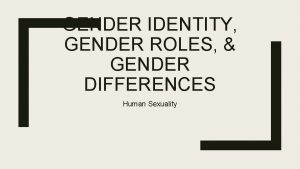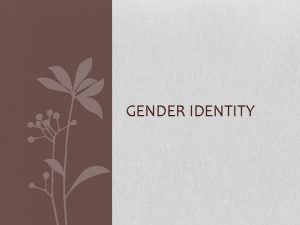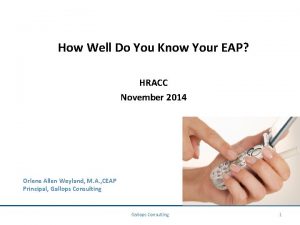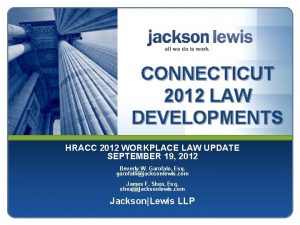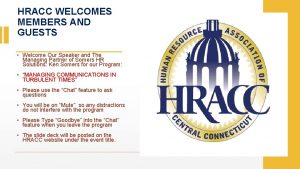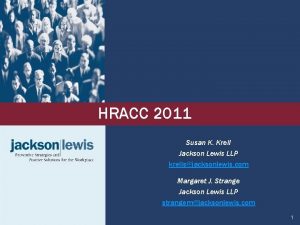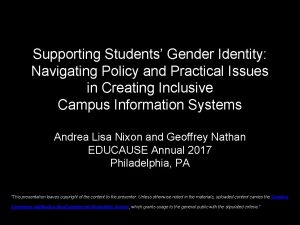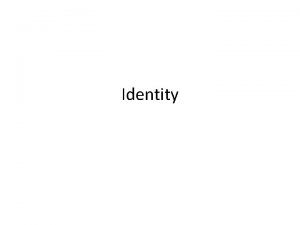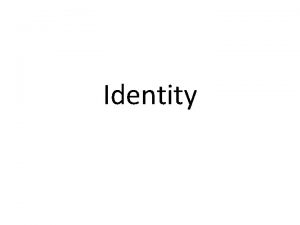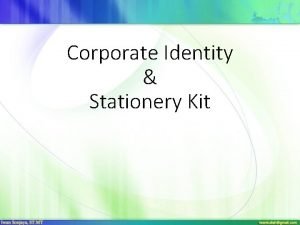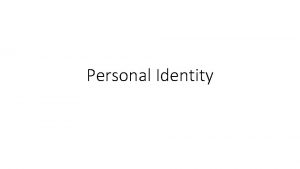HRACC 2016 Diversity Program HeSheTheyHirZe Navigating Gender Identity














































- Slides: 46

HRACC 2016 Diversity Program He/She/They/Hir/Ze - Navigating Gender Identity, Misgendering and Transitioning In The Workplace Presented By: Michelle E. Phillips, Esq. November 15, 2016 (914) 872 -6899 Michelle. Phillips@jacksonlewis. com Copyright 2016 1

Agenda · Review of sexual orientation/gender identity terminology and transphobia. · Federal/local gender discrimination laws and regulations. · Federal and EEOC sex stereotyping/transgender cases. · Gender Transition Plan. · Religious objections/accommodations. 2

Gender Identity & How it Differs from Gender Expression · Gender identity is a person’s innate, internal sense of his or her gender. · Gender expression is the way in which a person presents his or her gender to the outside world. · Transsexual is a person who changes or seeks to change their physical characteristics to a gender different from their biological sex. · Misgendering is refusing to use the proper pronoun when addressing a transgender individual. 3

Sexual Orientation vs. Transgender · Sexual orientation is an individual's physical and/or emotional attraction to the same or opposite gender. · Transgender is an umbrella term referring to a person whose gender identity presentation falls outside of stereotypical gender norms and may seek to change their physical characteristics through hormones, gender reassignment surgery or other actions. · Cisgender refers to individuals whose sex assignment at birth corresponds to their gender identity and expression. 4

Transitioning · Transitioning is the process through which a person modifies their physical characteristic/manner of expression in order to bring their internal gender identity in harmony with their external gender expression, such as the taking of hormones, gender reassignment surgery, covering certain body parts, changing speech patterns, hair, wardrobe, makeup or other changes. 5

What Would You Do? You heard a rumor from a reliable source that a transgender MTF employee is showing up to work as a female on Monday. What are your next steps? A. You contact the transgender employee. B. You contact the transgender employee’s manager. C. You wait until Monday to confirm whether or not the rumor is true. D. You wait until there is a complaint before taking any action. 6

What Would You Do? Other staff are complaining that they are uncomfortable with a “man” using the women’s restroom and they have “rights” too. Whose rights trump? A. The transgender woman has the right to use the women’s bathroom. B. The cisgender females have the right to exclude the transgender woman from using the ladies room. C. The transgender woman should be assigned to a separate restroom. 7

What Would You Do? A transgender FTM employee locks the men’s restroom whenever he uses it. Other staff complain that they have been denied access to the restroom. How do you handle the staff complaint? A. Based on invasion of privacy concerns, you allow the transgender male to continue to lock the men’s restroom. B. You post a sign indicating when the transgender employee is using the men’s restroom. C. You approach the transgender male and investigate why he is locking the restroom. 8

What Would You Do? A new hire checks the box “Female” on the EEO-1 form. A background report indicates that the employee is a “Male. ” You are concerned the new hire will be denied medical benefits based on a misrepresentation. What do you do? A. You approach the employee to discuss the issue. B. You contact the health insurance company. C. You wait until there is a denial of benefits before taking action. D. Not applicable because your policy has an exclusion denying transgender medical benefits. 9

What Would You Do? An applicant checks “Female” in the employment application and presents as female during the job interview. She is hired, and presents as a male at orientation and provides a male name. What do you do? A. Fire the new hire based on falsification of a company record. B. Change the personnel records from female to male. C. Use the male name on his email address/name badge. 10

Overview of Federal Gender Discrimination Laws · There is no federal law that protects against discrimination based on gender identity or expression. · As currently drafted, the Equality Act prohibits sexual orientation discrimination and discrimination based on gender identity or expression. · Title VII of the Civil Rights Act of 1964 prohibits discrimination “because of. . . sex. ” 11

State Anti-Discrimination Laws Protecting Transgender Employees · Nineteen states (CA, CO, CT, DE, HI, IL, IO, ME, MD, MA, MN, NV, NJ, NM, OR, RI, UT, VT and WA) and D. C. include gender identity and/or gender expression in their employment non-discrimination statutes. · Courts and human rights agencies in Connecticut, Colorado, Hawaii, Massachusetts, New Hampshire and New York have ruled transgender employees are protected by their state anti-discrimination laws. · New York’s Division of Human Rights adopted regulations affirming transgender individuals are protected under the state’s Human Rights Law 12

Federal/State Laws Prohibiting Discrimination Based On Disability · The Americans with Disabilities Act (“ADA”) excludes “transvestism, transsexualism, pedophilia, exhibitionism, voyeurism, gender identity disorders not resulting from physical impairments, or other sexual behavior disorders” from coverage. · ADA Final Rule on Wellness Programs – provides that on the basis of sex includes “gender identity, transgender status, and sexual orientation. ” o Effective July 18, 2016 13

Federal/State Laws Prohibiting Discrimination Based On Disability · State and local laws prohibiting discrimination based on disability may provide a significant source of protection for transgender employees. · The term “disability” in anti-discrimination laws refers to a wide range of serious health conditions and is meant to protect individuals from discrimination based on stereotypes and ignorance about medical conditions and disability 14

DOL and Federal Contractor Employees · DOL’s Office of Federal Contractor Compliance Programs (“OFCCP”) Directive 2014 clarifies that discrimination on the basis of “sex” under EI 11246 includes gender identity and transgender status. · DOL pledged to focus enforcement efforts on investigating and cracking down on employment bias against transgender federal contractor employees. · The OFCCP plans to “investigate individual and systemic complaints alleging sex discrimination against transgender employees. ” o See http: //www. jacksonlewis. com/publication/ofccp-s-new-sex-discrimination-regulationsimposes-few-new-obligations-employers 15

EEOC Litigation Charges & Guidelines · FY 2015: o EEOC received 1, 412 charges that included allegations of sex discrimination related to sexual orientation and/or gender identity/transgender status o EEOC resolved 1, 135 LGBT charges (including through voluntary agreements), providing approximately $3. 3 million in monetary relief for workers and achieving changes in employer policies so that discrimination would not recur. · July 21, 2016: EEOC: Title VII Prohibits Employment Discrimination Based on Gender Identity, Sexual Orientation o See http: //www. jacksonlewis. com/publication/eeoc-title-vii-prohibits-employmentdiscrimination-based-gender-identity-sexual-orientation 16

Price Waterhouse v. Hopkins (1989) · U. S. Supreme Court decision in Price Waterhouse v. Hopkins, 490 U. S. 228 (1989) held that a woman who failed to conform to her employer’s gender stereotypes regarding how women should look and act was protected from discrimination by Title VII. · Hopkins, a female accountant, was advised by certain partners in the firm that she could improve her partnership chances if she would “walk more femininely, talk more femininely, dress more femininely, wear make-up, have her hair styled, and wear jewelry. ” 17

Price Waterhouse v. Hopkins (1989) (Cont. ) · Hopkins sued under Title VII for sex discrimination after she resigned following the firm’s denial of partnership. · Justice Brennan, writing for the plurality, held that “in the specific context of sex stereotyping, an employer who acts on the basis of a belief that a woman cannot be aggressive, or that she must not be, has acted on the basis of gender. ” 18

Macy v. Holder (EEOC Apr. 20, 2012) · Job applicant Mia Macy applied for a job at the Bureau of Alcohol, Tobacco, Firearms, and Explosives (“ATFE”). · When Macy applied for a job, she presented as male. · Shortly thereafter, Macy informed ATFE that she was transitioning from male to female. · ATFE informed Macy that another applicant had been hired because that applicant was farther along in the background check process. 19

Macy v. Holder (Cont. ) (EEOC Apr. 20, 2012) · Macy filed a complaint against ATFE with the EEOC alleging that the reasons proffered for not hiring her were pretextual and that the true reason was because of her “sex, gender identity (transgender woman) and on the basis of sex stereotyping. ” · The EEOC reasoned that Macy could establish a viable sex discrimination claim on the ground that: o ATFE believed that biological men should present as men and wear male clothing; or, o ATFE was willing to hire a man, but not a woman. · Either way, the EEOC concluded, transgender discrimination is discrimination “based on. . . sex” and violates Title VII. o See http: //www. jacksonlewis. com/resources-publication/title-vii-prohibits-discriminationagainst-transgender-workers-eeoc-decides 20

EEOC v. Lakeland Eye Clinic (M. D. Fla. 2014) · Six months into his employment, Branson started wearing feminine attire to work, including makeup and women’s tailored clothing. Co-workers noticed and snickered and rolled their eyes. · Soon after, Lakeland confronted Branson about her changing appearance. She explained that she was undergoing a transition from male to female. · Following this meeting, Lakeland’s managers and employees made derogatory comments about her appearance, and the ostracism intensified. The physicians stopped referring clients to Branson. Two months later, Defendant discharged Branson, telling her that the position was being eliminated. Branson was replaced by a male employee. 21

EEOC v. Lakeland Eye Clinic (Cont. ) (M. D. Fla. 2014) · On April 9, 2015, the EEOC entered into a historic $150, 000 settlement and consent decree with Lakeland Eye Clinic. · Lakeland was required to implement a new gender discrimination policy; and · Lakeland was required to provide training to management and employees regarding transgender/gender stereotype forms of discrimination. 22

EEOC v. RG & GR Harris Funeral Homes (E. D. Mich. 2014) · Aimee Stephens was employed by Defendant since 2007. · In July 2013, Stephens notified her employer and her co- workers that she was undergoing a gender transition from male to female and intended to dress in appropriate business attire as a woman and asked for their support. Two weeks later, Defendant fired Stephens, telling her that what she was “proposing to do was unacceptable. ” · Employer’s motion to dismiss denied because, under 6 th Circuit law, the complaint stated a valid claim for sexstereotyping and sex discrimination 23

EEOC v. RG & GR Harris Funeral Homes (E. D. Mich. 2016) · Employer’s motion for summary judgment granted · Funeral home raised RFRA defense o Court found substantial burden on the exercise of the funeral home’s religion • Court assumed EEOC established compelling state interest • BUT it failed to show it utilized the least restrictive means to effect that compelling state interest (no evidence that EEOC proposed anything other than allowing Stephens to wear a skirt) o See http: //www. jacksonlewis. com/publication/court-dismisses-religious-freedom-groundseeoc-s-title-vii-suit-behalf-fired-transgender-employee 24

Robinson v. Dignity Health (N. D. Cal. 2016) · Robinson, a FTM transgender, receives health care coverage through his employer, paid out of pocket for hormone therapy related to his gender dysphoria · Plan categorically excludes “treatment, drugs, medicines, services and supplies for, or leading to, sex transformation surgery. ” · Filed suit claiming sex discrimination under Title VII and Section 1557 of the Affordable Care Act · August 10, 2016: Transgender bias case against Dignity Health could set off religious freedom clash o See http: //www. modernhealthcare. com/article/20160810/NEWS/160809895/transgender 25

Restroom Accessibility · OSHA: A Guide to Restroom Access for Transgender Workers o All employees, including transgender employees, should have access to restrooms that correspond to their gender identity · OPM: Guidance Regarding the Employment of Transgender Individuals in the Federal Workplace · EEOC: Fact Sheet on Bathroom Access Rights o See http: //www. jacksonlewis. com/publication/eeoc-stresses-titlevii-bars-discrimination-against-transgender-workers-includingregarding-bathroom-access 26

G. G. v. Gloucester County Public School Board (4 th Cir. 2016) · Transgender male student alleged school district’s policy of barring him from using the boy’s bathroom violated Title IX. · District Court found policy did not violate Title IX. · 4 th Circuit deferred to Dep’t of Education interpretation of 34 C. F. R. § 106. 33 (permitting separate bathrooms/locker room facilities on the basis of sex so long as they are comparable) as requiring schools to permit transgender students to use bathroom congruent with gender identity. · SCOTUS granted stay pending filing of writ of certiorari 27

Texas v. United States (N. D. Texas 2016) · May 13, 2016: DOE and DOJ issue guidance making clear that the departments “treat a student’s gender identity as the student’s sex for purposes of Title IX and its implementing regulations. ” o See http: //www. jacksonlewis. com/publication/us-departments-justice-andeducation-issue-significant-guidance-transgender-rights-under-title-ix · Texas (and 12 other states) seek declaratory and injunctive relief relating to departments’ guidance · August 21, 2016: District Court issues nationwide injunction o Departments bypassed required notice and comment process o Found 34 C. F. R 106. 33 unambiguous and guidance not entitled to agency deference 28

Single-Sex Multiple Occupancy Act (“HB-2”) · Bill expressly preempts local laws which would expand protections to LGBT community · Defines protected class to include “biological sex, ” NOT gender identity (in both employment and public accommodation contexts) o “Biological sex” – “The physical condition of being male or female, which is stated on a person’s birth certificate. ” · Individuals required to use bathroom facility corresponding with biological sex · Eliminated private right of action 29

North Carolina Articles · March 28, 2016: North Carolina Legislation Removes LGBT Protections and Possible Wrongful Termination Claims o See http: //www. jacksonlewis. com/publication/north-carolina-legislation-removes-lgbtprotections-and-possible-wrongful-termination-claims · March 29, 2016: HB-2 Anxiety over Transgender Women in Restrooms Persists o See https: //www. shrm. org/legalissues/stateandlocalresources/pages/north-carolinatransgender-lgbt. aspx · May 5, 2016: Department of Justice Warns Governor that North Carolina LGBT Law is Unlawful o See http: //www. jacksonlewis. com/publication/department-justice-warns-governor-northcarolina-lgbt-law-unlawful · August 31, 2016: HB-2 Ruling Might Be ‘First Domino’ o See https: //www. shrm. org/resourcesandtools/legal-and-compliance/state-and-localupdates/pages/hb-2 -title-ix-ruling. aspx 30

Massachusetts H. B. 4343 · “Any public accommodation, including, without limitation, any entity that offers the provision of goods, services, or access to the public, that lawfully segregates or separates access to such public accommodation or other entity based on a person’s sex shall grant all persons admission to and the full enjoyment of such public accommodation or other entity consistent with the person’s gender identity. ” · Effective October 1, 2016 · August 19, 2016: Massachusetts Enacts Transgender Restroom Law o See http: //www. jacksonlewis. com/publication/massachusetts-enacts-transgender -restroom-law 31

Gender Transition Plan The transition plan should address the following issues: • Timeline; • Facilities usage; • Dress code; • Appropriate norms of conduct; • Company resources; • Identification changes; • Security clearance issues; • Sensitivity training; • Complaint procedures; • Plan modifications. 32

GENDER TRANSITION PLAN • What are the staff communications/training and other preparations for the go live date? • Will the transgender employee be present for the training? • What if there are religious objections to the transition? • What if there are violations of the Harassment Policy? • How should confidentiality regarding medical information be addressed? • What documentation is required for the name change? • How will issues of medical coverage be addressed? 33

Peterson v. Hewlett-Packard – Religious Objections · Peterson v. Hewlett-Packard Co. , 358 F. 3 d 599 (9 th Cir. 2004) · Peterson was employed in the Boise, Idaho office of Hewlett-Packard (HP) for almost 21 years and his performance was satisfactory. · HP began a diversity campaign, and displayed diversity posters. • The first series consisted of five posters, each showing a photograph of an HP employee above the caption “Black, ” “Blonde, ” “Old, ” “Gay, ” or “Hispanic. ” • Posters in the second series included photographs of the same five employees alongside a description of the featured employee’s personal interests and the slogan “Diversity is our Strength. ” · Peterson described himself as a “devout Christian, ” who believed that homosexuality violates the commandments he found in the Bible and that he has a religious obligation “to expose evil when confronted with sin. ” 34

Peterson v. Hewlett-Packard • In his work cubicle, Peterson posted three Biblical scriptures in large font which are often cited to condemn homosexuality (Corinthians 10: 12, Isaiah 3: 9, and Leviticus 20: 13). • Peterson’s direct supervisor removed the passages – determining they violated HP’s policy prohibiting harassment. • Peterson said, “the scriptural passages were intended to be hurtful. And the reason they were intended to be hurtful is you cannot have correction unless people are faced with truth. ” • Peterson’s position: Either HP could remove the “gay” poster, or it could allow Peterson to post the Bible verses. • HP rejected these alternatives, and gave Peterson time off with pay to reconsider his position. • On his return, Peterson reposted the scriptures, refused to remove them, and was terminated for insubordination. Peterson sued. 35

Peterson v. Hewlett-Packard – The Decision • Hewlett-Packard won in the district court, and Peterson appealed. • On appeal, the court upheld the decision in favor of HP. • Peterson offered no evidence that his termination was the result of disparate treatment based on his religion. • His termination resulted from his insubordination and because he generated a hostile and intolerant work environment. • Both of Peterson’s suggested accommodations would have imposed an undue hardship on the company, inhibiting: • HP’s ability to attract and retain a diverse workforce, including lesbian, gay, bisexual or transgender persons; and • HP’s commercial success. 36

Peterson – Best Practices • HP’s managers evidenced best practices: • Asked about Peterson’s specific objections. • Had conversations about Peterson’s intent. • Attempted to reach a compromise accommodation. • Did not attempt to change his beliefs. • Gave Peterson a second chance. • Intent can matter - court distinguished motivation: • Other employees and managers were allowed to send out communications promoting LGBT inclusion. 37

Gadling-Cole v. West Chester Univ. (E. D. Pa. Mar. 30, 2012) • Charnetta Gadling-Cole was an adjunct professor at West Chester University in the social work department. • All 5 other professors in the social work department advocated for the LGBTQ community. • Gadling-Cole refused to support the LGBTQ community, claiming it conflicted with her Baptist religious beliefs. • She claimed that, as a result, her colleagues refused to work with her, excluded her from meetings, criticized her, and voted against giving her a tenure-track position (awarding it instead to an allegedlyunqualified candidate). • She complained to her supervisor; nothing changed. 38

Gadling-Cole v. West Chester Univ. (E. D. Pa. Mar. 30, 2012) • Court held that a reasonable jury could find that Gadling-Cole was discriminated against on the basis of her religion. • The university could be held vicariously liable for not taking action to rectify the religious harassment. 39

Steps to Accommodation • Employee must come forward and advise the employer he/she has a bona fide religious belief that conflicts with a duty owed to the employer. • Employer must engage in an interactive dialogue with the employee in an attempt to remove the conflict unless doing so would result in an undue hardship to the employer. 40

Steps to Accommodation • Employer can only refuse to accommodate a religious employee when “each available alternative” has been explored and cannot be done. • Employer need not provide the employee with the accommodation favored by the employee. • However, an employer must offer the alternative that least disadvantages the employee in terms of his/her employment opportunities. 41

What constitutes an “Undue Hardship” Impact on other employees Financial cost (de minimis) Least restrictive alternative Result? 42

The DO’s and DON’T’s of Religious Accommodation in the Workplace • DO Adopt an inclusive diversity policy • Communicate and be flexible • Regulate conduct, not beliefs • Take steps to prevent religious harassment • • DON’T Leave anyone out Take a hard position Deny accommodation before investigating whether it can be provided without undue hardship Force employees to participate in religious activities 43

BEST PRACTICES · Subjects of gender stereotyping and gender identity/expression can and should be addressed: • Develop a strong EEO policy, train managers and employees on its contents and procedures, and follow and enforce it. • Make employment decisions transparently and document the job -related reasons for employment decisions. • Implement recruitment, hiring and promotion practices designed to widen and diversify the pool of candidates considered for employment openings. • Self-analyze to determine whether neutral employment policies or practices disadvantage people of a particular protected group. 44

BEST PRACTICES (Cont’d) • Create objective, job-related qualifications standards, and make sure they are consistently applied. • Provide training and mentoring to give workers of all backgrounds the opportunity, skill, experience, and information necessary to perform well, and to ascend to upper-level job. • Promote an inclusive workplace culture. • Foster open communication and early dispute resolution to minimize the chance that a misunderstanding may escalate into an EEO issue. • Protect from retaliation employees who raise concerns or make complaints about discrimination. 45

Questions? Presented By: Michelle E. Phillips, Esq. November 15, 2016 (914) 872 -6899 Michelle. Phillips@jacksonlewis. com 46
 Peterson vs. hewlett packard
Peterson vs. hewlett packard Brit cervantes
Brit cervantes Strategic gender needs and practical gender needs
Strategic gender needs and practical gender needs Centre for gender diversity and inclusion statistics
Centre for gender diversity and inclusion statistics Centre for gender diversity and inclusion statistics
Centre for gender diversity and inclusion statistics Gender based violence
Gender based violence Gender and development
Gender and development Sexual orientation gender identity
Sexual orientation gender identity Gender identity
Gender identity Gender identity tagalog
Gender identity tagalog Genetic diversity and biodiversity
Genetic diversity and biodiversity Genetic diversity vs species diversity
Genetic diversity vs species diversity Rsa identity management and governance img
Rsa identity management and governance img Navigating the body
Navigating the body Navigating the digital landscape
Navigating the digital landscape Cadet rule in navigation
Cadet rule in navigation Math bearings
Math bearings Aws cognito gdpr
Aws cognito gdpr Navigating the art world
Navigating the art world Aws iaa
Aws iaa A.backtoschool
A.backtoschool Identity theft prevention program
Identity theft prevention program Gender punnett square
Gender punnett square Xxy gender
Xxy gender Gender action plan world bank
Gender action plan world bank Gender action plan world bank
Gender action plan world bank Wid wad gad
Wid wad gad Unesco
Unesco George keith and john shuttleworth
George keith and john shuttleworth The simple truth about the gender pay gap
The simple truth about the gender pay gap Define gender constancy
Define gender constancy Is the lifelong process of social interaction through which
Is the lifelong process of social interaction through which Gender definition
Gender definition Snow white gender roles
Snow white gender roles Xxy chromosome gender
Xxy chromosome gender Adn
Adn Gender-neutral housing pros and cons
Gender-neutral housing pros and cons Moser framework tools
Moser framework tools Is there any bias in gender roles based on the excerpt
Is there any bias in gender roles based on the excerpt Lesson 5 punnett squares and pedigrees answer key
Lesson 5 punnett squares and pedigrees answer key Paradigm shift from women studies to gender studies
Paradigm shift from women studies to gender studies Mbti by gender
Mbti by gender Canalization gender examples
Canalization gender examples Performative acts and gender constitution judith butler
Performative acts and gender constitution judith butler Gender criticism definition
Gender criticism definition Feminist criticism in the story of an hour
Feminist criticism in the story of an hour What is gender mainstreaming?
What is gender mainstreaming?
